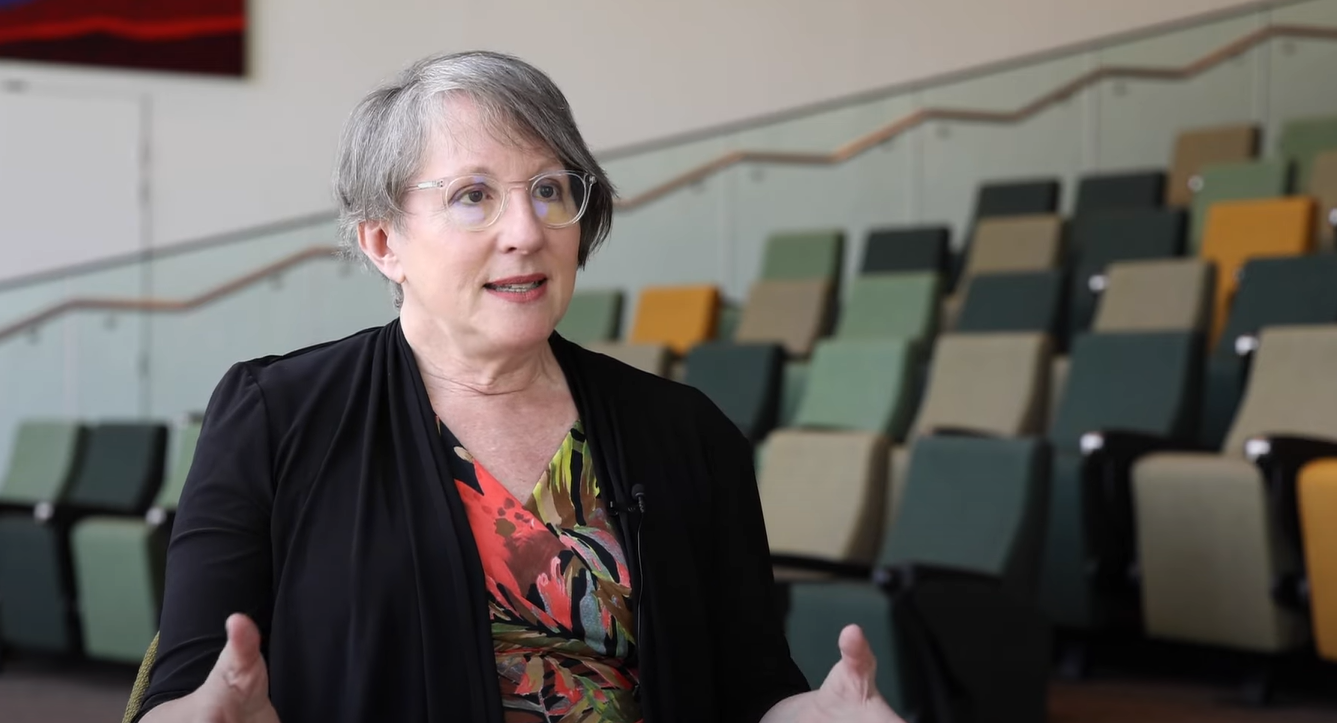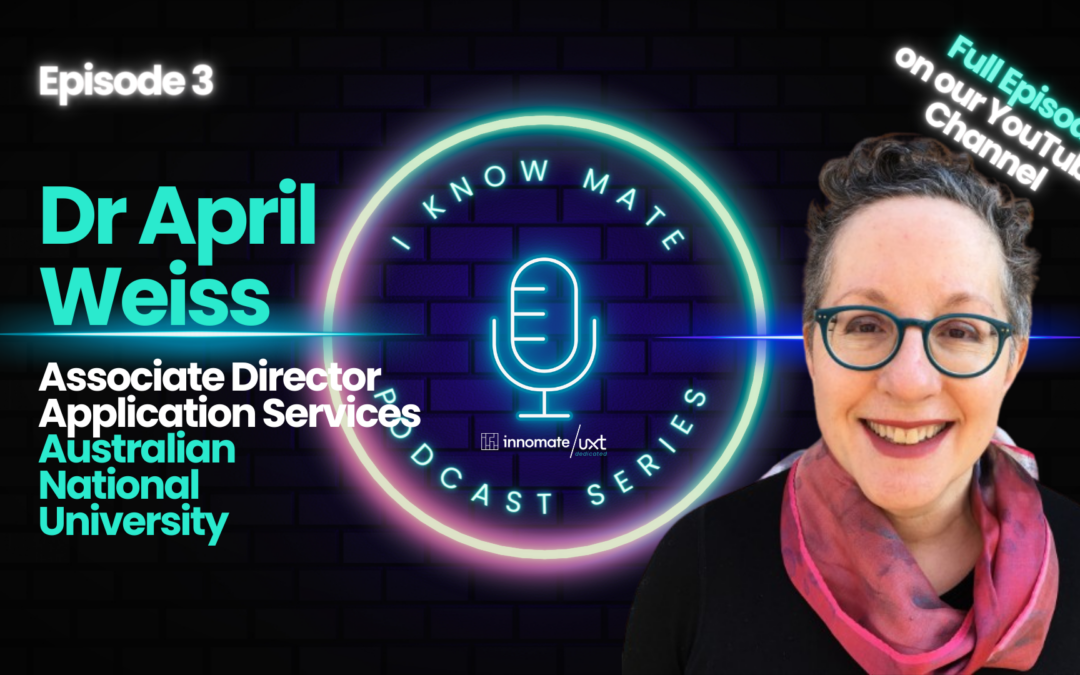Towards the end of 2023, we had the pleasure of interviewing Dr. April Weiss, Associate Director of Application Services at the Australian National University, to hear her expert views on Audio Visual transformation in education. Join us as we dive into a captivating conversation with April about her groundbreaking work at the ANU, and learn about her journey from IT enthusiast to a leader in audio-visual transformation and technology in the higher education sector. Gain valuable insight from Dr. Weiss’ strategies for understanding and meeting the diverse needs of university technology users, and the significant impact the pandemic had on remote learning for universities. Dr. Weiss also highlights the vital role Innomate and UXT played in transforming the ANU’s AV infrastructure, ensuring seamless support and high-quality service across one of the countries largest number of learning spaces.
Dr April Weiss’s mission at ANU – Audio Visual Transformation in Education
Neil: Could we start by you telling us a little bit about your mission here at ANU and the incredible feat that we’re about to dive into?
April: Well, it started a long time ago, when I first went to a university, and I was interested in helping them progress their learning approach, and at the time, it was all about online learning, and I thought, “How on earth does anyone make any change in an organisation like this?”, because it’s never fully centralised, they are heavily decentralised. I became focused on what people need at a university and how to make that change. At the time, I felt quite small and insignificant within the university structure, but that was my goal. I didn’t go there to be a great project manager. That was my entry point into the universities, to go and take on this role, and my goal was to work out what it is that people need and how to make those changes.
Neil: That’s very interesting! I’d love to know more about your career path; certainly, with the exceptional things that have been completed and achieved here at ANU, how did you find yourself in the audio-visual technology world?
April: Well, it started in high school; I was quite interested in technology. Not in AV itself but in IT, and the high school I was at had one of the old original ENIAC computers and an absolute guru to teach us. I thought that was very interesting, so it started back then. And then when I went to University, again I looked at “what can we do with computers?” I didn’t do a computing degree, but I took courses as I could, and then my second degree was in computing. When I went to work in IT, I was interested in everything, so I worked in applications, infrastructure, and multimedia, and I worked in all the different areas.
Neil: And do you think you steered your career, or do you think serendipity took over to a degree, or was it situational?
April: I think it was situational because I always had that goal of making large changes in a large organisation. I have always had an interest in the application and infrastructure, and then one day, I was given a role in infrastructure. With it came the AV area, and I thought that was fun. And then that was the start of working with AV, so I had that at RMIT for a very long time. Again, I became very interested because it’s so fundamental to the University.
Managing the diverse needs of individual users during Audio Visual transformation in Education
Neil: Do you know what individual users need now?
April: There isn’t one answer. When we are working on audio-visual, which we like to call learning space technology here, we like to gather the people who are using the room, the people who are making decisions about the room, the people who will be representing others perhaps with accessibility and disability needs and so on. We bring them all together, and recently, we did this and we had a rolling session across 3 days. The first session was about what is technically and physically possible, and then from there, it’s like what are we doing with this space, what will you be doing, and what would you like to have in the space? Then, we did this collaborative user requirement. What is it that you’ve seen before that you would like to have? Now, that should never limit us because technology is improving all the time, but we get it from the people who are using the rooms and spaces and are most impacted.
Neil: So do you find yourself in those scenarios coming up with a lot of asks or requirements where you can do something, but you find yourself asking if we should do this?
April: Absolutely! We bring in people who are not necessarily in the heart of the AV world, so we had our human-centred design people running the last sessions, and one of them is an academic as well. So there is a lot of discussion, and then we take it away and work on it. We were very time-limited, so the University is working on hell remediation – it’s a larger centre, it seats 1,200 people, and it’s a concert hall. All those students who would normally go in for the larger classes now needed to migrate somewhere else, so this was needed in a very short period of time. So what can we do? What are all the wishes, what can we do now, and what can we bring in in the second semester?

Dr. April Weiss of the ANU talks with Neil Collins from Innomate about Audio Visual Transformation in Education.
The commercial world post-pandemic
Neil: Do you think the pandemic opened the eyes of the rest of the commercial world to the things that people like yourself were already doing, sort of 5 years ago, to try and get ahead of what would be next in remote learning and a broad spectrum of spaces?
April: It certainly opened the University’s eyes because I was running the online learning program, and this University likes people to come in and work with outstanding academics; they like the students to be physically present, so with the online learning, I was challenged every time. I had to do a budgetary uplift; they would always say, “Do we need any of that? Do we need as much of that?”. And then, of course, when the pandemic hit, the University closed down over a 3-day period, and all the students and all the staff were transferred to online learning, so overnight, it just scaled up. The University was able to then transfer, and they had to get used to teaching this way, but at least the technology wasn’t blocking them. And, of course, people started using Teams and Zoom and then became very comfortable talking to students anywhere in the world using the unified communication approach.
The role UXT and Innomate have played in the ANU’s Audio Visual transformation journey
Neil: We talked a little bit about the incredible journey that’s going on here and the influences around and the characters that have gone into supporting what’s been done here. What sort of role have Innomate and UXT played in that journey?
April: A significant role! The UXT and Innomate journey has been a very supportive and collaborative journey that started at a time when we had a huge number of support incidents that were unresolved and unresolvable for a number of factors, including the rate they were coming in and the age of the equipment. So, there were more and more incidents coming, and we asked for support to support our team. I remember when UXT came in, and there were 261 open tickets, and it was just before the start of the semester, so that was huge. So we worked closely together, and they took off. They just worked consistently until we went from 261, and then, at the next minute, we were at 60. And then there were like harder, much harder tickets, and then we’re down to 20 of the really, really difficult tickets. We were able to remove them all, but it was terrific. Over time, they took over that whole service, so it was great. What we did is that we didn’t look after all the rooms, although we will now going forward, so we were able to say that these 330 rooms will get this rolls- royce treatment, they will have the support and the high quality of uplift and at the same time have a dialogue with the University around, what is required in these spaces, but we were able to focus on a very large subset of key mainly lecture theatres like this but also significant meeting spaces. We went from support, and I’ll just go back to or continue on the support side, so over time, one of the big problems that our service desk faced is when somebody is in front of 1200 students, and the equipment fails, so the person who takes the call gets the brunt of that and the person who is in front of the students could get a very bad ranking that could harm their career so it’s high pressure. So, one of the things we did was bring in a telephone centre, or we asked UXT to establish one that was staffed with engineers. Engineers that knew the University and had access to innomesh and the remote support, so they could work from wherever they were located, supporting us remotely and not only taking the calls but being able to answer the calls. So, for example, we had a call go through to our service desk, saying that the document camera was not working, so we asked if it was an Apple or a Google phone and we needed people on the other end who understood what a document camera was and what could go wrong. All of our rooms are different; we are standardising, but there’s a lot of old equipment out there; in one room, there was even a tape recorder with a microphone attached to it, and somebody did ask for it to be integrated with our lecture capture system which wasn’t quite something we were able to do, but we were able to provide another solution.
We’d like to thank Dr. April Weiss for joining our podcast and sharing her insightful story and expertise in Audio Visual transformation in education with us (and you). To our readers, keep an eye out for more fascinating talks on the future of work and tech. Make sure to subscribe to our podcast on Spotify and YouTube and turn on notifications so you never miss an episode!
You can also watch the full episode here.


